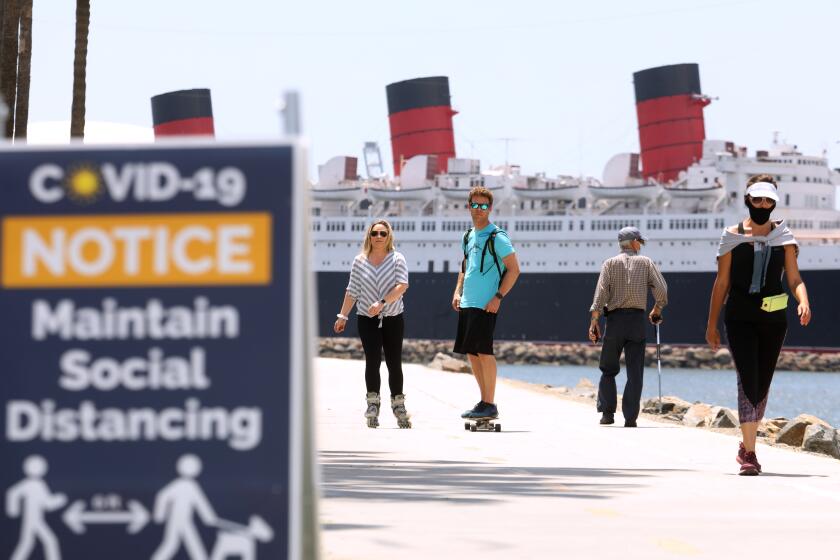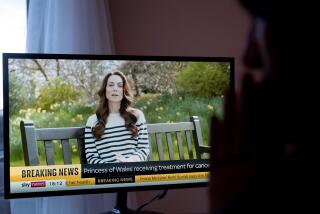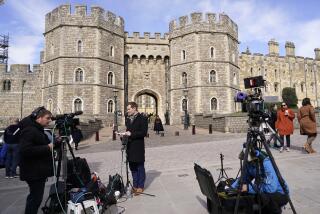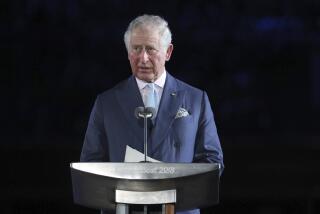Britain’s Boris Johnson in intensive care, illustrating U.K.’s growing struggle with coronavirus
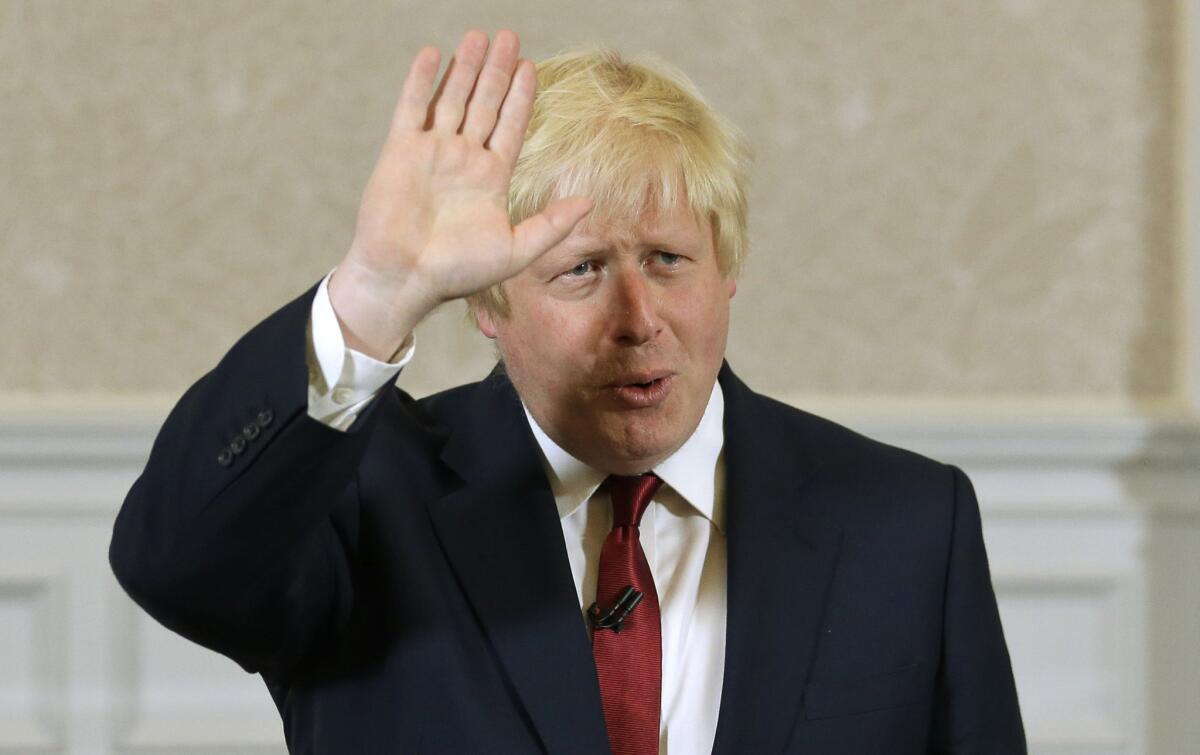
- Share via
LONDON — British Prime Minister Boris Johnson, infected by the coronavirus, was moved Monday to intensive care at a London hospital, a dramatic development illustrating his country’s escalating battle with the outbreak.
The first major world leader to be so seriously sickened with COVID-19, the 55-year-old prime minister’s move to a stepped-up level of care came less than 24 hours after he was hospitalized, ostensibly for tests.
He tested positive for the virus on March 26 and acknowledged persistent symptoms including a fever and cough. In a video released Friday, he looked markedly ill, puffy-eyed and subdued, a far cry from his usual ebullient self.
His foreign secretary, Dominic Raab, was deputized to step in as necessary for Johnson, who had been reported earlier in the day to be tending to government affairs from his hospital bed.
Johnson’s fate added new uncertainty to a fractious government led by one of Europe’s most polarizing figures. Quick of wit and at times blustery in temperament, Johnson helped lead Britain out of the European Union while upending the nation’s politics with his brand of unapologetic populism.
After Johnson’s hospitalization was disclosed Sunday, President Trump called the prime minister a personal friend and “great gentleman,” expressing hopes for his recovery.
In recent years, Britain and the United States have shared a certain political zeitgeist, with Brexit and Johnson’s rise both preceding and echoing the populist presidency of Trump.
That transatlantic pas de deux continued into the early days of the coronavirus crisis, with Trump and the British leader both striking an initially dismissive stance about the dangers of COVID-19, the respiratory illness caused by the virus.
But now the two countries’ responses to the outbreak may be diverging, even as the near-term epidemiological trajectories in Britain and the United States appear similarly grim.
Less than two weeks before being hospitalized Sunday, Johnson shifted his stance on the outbreak, ordering a March 24 lockdown allowing only essential movement in public. His government now strongly advocates physical distancing measures, consistently pleading with Britons to stay home and save lives.
Queen Elizabeth II, who turns 94 this month, delivered a rare televised address to the nation Sunday evening that was widely hailed as a pitch-perfect expression of both dauntlessness and somber realism about the outbreak’s gravity.

Trump has been far more equivocal. He approved voluntary 30-day guidelines meant to slow the spread of the virus, but has turned aside calls for a national stay-at-home order and repeatedly voiced hopes that the country would soon be up and running again.
On Sunday, the president again predicted the now-battered U.S. economy would take off “like a rocket” when the outbreak eases. Experts say such an economic opening is far from imminent.
“LIGHT AT THE END OF THE TUNNEL!” Trump tweeted Monday morning.
Britain, like the United States, is facing a projected increase of illness and fatalities in coming days.
During the weekend, the country marked an unwelcome milestone, surpassing devastated Italy in daily coronavirus deaths. Britain’s fatality toll as of Monday — more than 5,000 — was roughly half the total coronavirus deaths in the United States, whose population is about five times larger.
The United States, too, is on course for an extraordinarily bleak week, public health officials say. The surgeon general, Jerome Adams, on Sunday likened the coming seven days to Pearl Harbor or the terrorist attacks of Sept. 11, 2001.
As recently as the weekend, Trump was almost jocular when asked about the close physical clustering of senior aides at near-daily White House coronavirus briefings. Johnson was seemingly casual about that kind of contact as well — until he, Health Secretary Matt Hancock and England’s chief medical officer, Chris Whitty, all tested positive for the virus in the last week of March.
Hancock and Whitty recovered, and even after Johnson was hospitalized, initial reports were positive. The prime minister’s office said earlier Monday he had spent a “comfortable night” at London’s St. Thomas’ Hospital.
But even then, aides refused to address news reports that he received oxygen treatment, though they stopped describing his symptoms as mild.
Coronavirus: L.A. officials urged residents to avoid shopping, stay indoors this week as deaths rise
The outbreak’s course in Britain and the United States have followed some common pathways, but on a few crucial points, the similarities break down.
As people have done in New York City, the epicenter of the U.S. outbreak, Britons have been taking to balconies and doorsteps for raucous, pot-banging rounds of applause for frontline health workers, a number of whom have died of or been sickened by COVID-19.
But while the U.S. and British publics share warm public sentiments toward individual doctors, nurses and others who care for coronavirus patients, the outbreak is seen in the U.K. as a ringing affirmation of its system of universal healthcare. In the United States, appreciation for medical workers is coupled with uninsured or underinsured patients’ fears of being bankrupted by the cost of care.
Although Britain’s National Health Service headed into the crisis already burdened by a long-term budget crunch, it has been holding its own even as the caseload inexorably rises.
In just nine days, marshaling hundreds of soldiers and a team of architects, the government set up a vast temporary hospital at a conference center in East London. Prince Charles — the 71-year-old heir to the throne, who suffered his own bout of COVID-19 — presided over last week’s ceremonial opening, but remotely.
New York City, with a measure of federal assistance, has also responded with swiftly assembled makeshift facilities, but individual hospitals have been staggering under the influx of critically ill patients. And state Gov. Andrew Cuomo — like many of his counterparts — has complained that individual states have been largely left to go it alone in obtaining crucial supplies.
While Trump has continued to lash out at domestic political opponents throughout the coronavirus crisis, Britain’s polarized political establishment has, for the moment, largely put aside bitter divisions over Brexit, the country’s exit from the European Union that took formal effect at the end of January.
In this historic moment, the free world is led by a man whose greatest talent is to divide, mock, insult, alienate.
Before the outbreak took hold, Scotland’s first minister, Nicola Sturgeon, was spearheading demands for a second Scottish independence referendum, reflecting most Scots’ wish to stay in the EU, while Britain as a whole voted in 2016 to leave, 52% to 48%.
But Sturgeon, previously an unrelentingly sharp critic of the prime minister, has pivoted to working with him to help stem the spread of the coronavirus and shore up the healthcare system. The outbreak “demands that Nicola Sturgeon and Boris Johnson cooperate, and so far it appears they are doing so,” the Scotsman newspaper noted in an approving editorial.
Britain’s opposition Labor Party — which went head-to-head with Johnson in December in one of the most bitter general election campaigns in recent memory — over the weekend installed a new leader, Keir Starmer. He said he would speak out where he saw flaws in the government’s strategy, but promised for the duration of the crisis to steer clear of “opposition for opposition’s sake.”
And Britain possesses a singular weapon in its fight to rally the country in the face of the coronavirus: its doughty monarch, whose televised address from Windsor Castle was likened to the iconic radio speech delivered in 1939 by her father, King George VI, as war clouds threatened.
Composed and calm, wearing one of her signature brooches, Elizabeth urged Britons to show solidarity and resolve.
“I hope in the years to come, everyone will be able to take pride in how they responded to this challenge,” she told her compatriots.
Across the Atlantic, royal watchers and public intellectuals took note of the value of inspirational rhetoric at such a moment.
“Though I lived in Britain for many years, the monarchy always felt alien to me; if you’re not raised to feel reverence for it, you never will,” tweeted German American academic and author Yascha Mounk, now based in Washington. “And yet, this brave, sensible woman puts into relief what America so desperately lacks: a head of state capable of uniting the nation.”
The queen acknowledged the “painful sense of separation” as people must keep their distance from one another to prevent the spread of infection. But Elizabeth, alluding to the lyrics of a World War II-era song, also held out the implicit promise of a return to normal life — even if a post-coronavirus era now seems impossibly distant to some.
“We will meet again,” she said.
Special correspondent Boyle reported from London and Times staff writer King from Washington.
More to Read
Sign up for Essential California
The most important California stories and recommendations in your inbox every morning.
You may occasionally receive promotional content from the Los Angeles Times.
